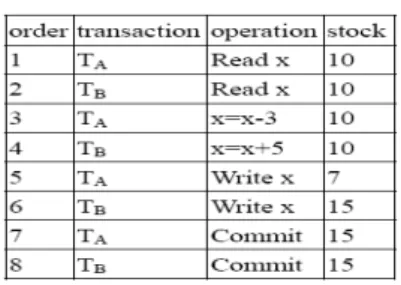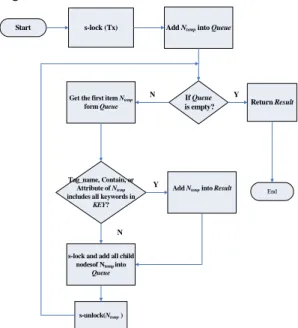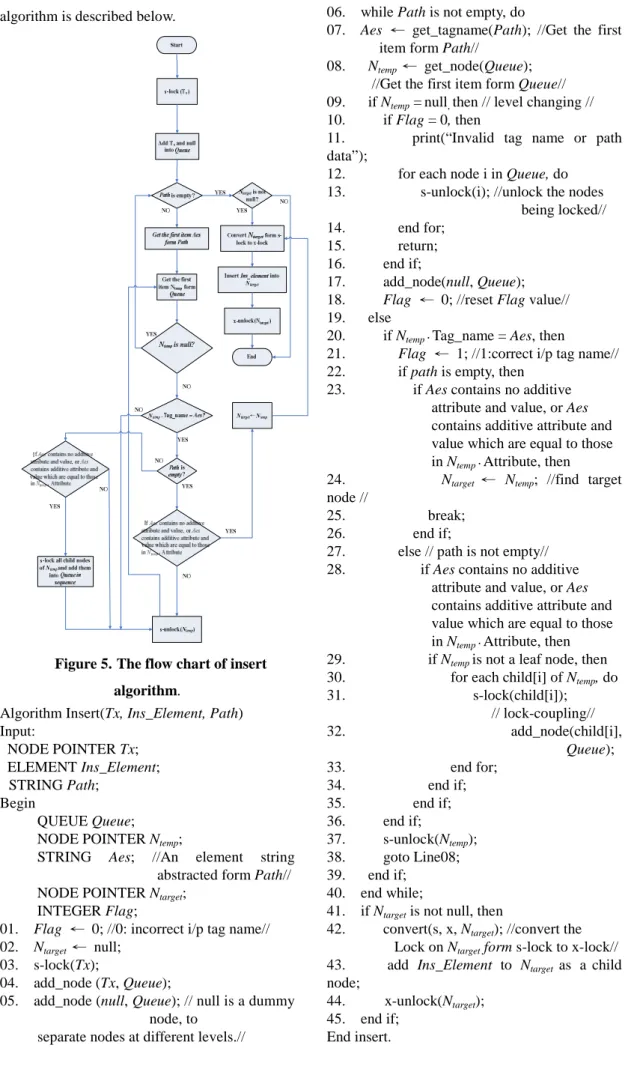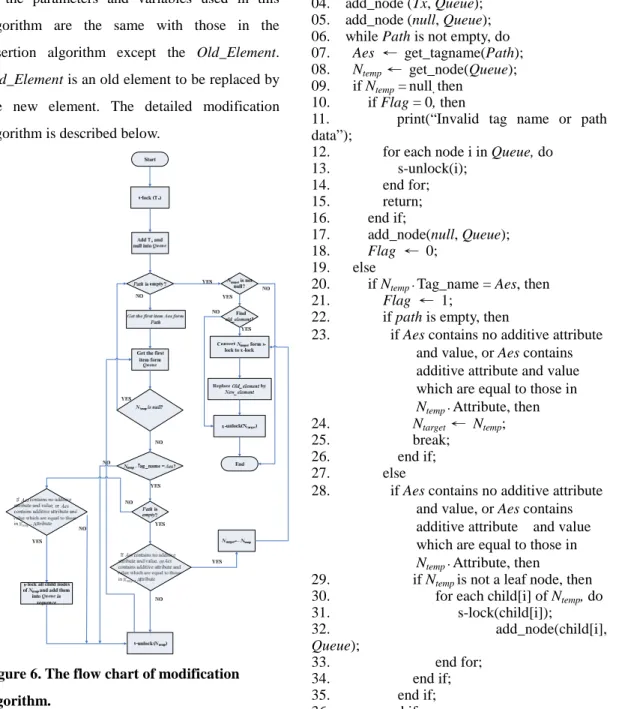Concurrency Control Access of Dynamic XML Document with
the Locking Method
Jeang-Kuo Chen*, Kuan-Chang Lu
Department of Information Management, Chaoyang University of Technology
jkchen@cyut.edu.tw, s9514637@cyut.edu.tw
ABSTRACT-
XML is a popular media in many commercial transactions. It is necessary to support XML document access by multiple users concurrently. The access method of single-user for XML document is unsuitable in a multi-user environment. In this paper, we propose three concurrency control algorithms for searching, inserting, and modifying relative element data in a dynamic XML document. With the locking techniques, the algorithms allow multiple users to concurrently access the same data without any error occurrence.Keywords ︰ Concurrency Control, XML, Locking, Access Method.
1. Introduction
The XML (eXtensible Markup Language) [12] is popular in many commercial applications such as electronic commerce, data exchange, data warehouse etc [1, 5, 6, 8, 9, 10, 11]. With a DTD or an XML Schema, an XML document can be verified to be a valid document or not. When the quantity of XML documents increases quickly in a company, it is necessary to manage XML documents with a database management system in order to facilitate management and access of XML documents [4, 7, 9, 14, 15]. A concurrency control mechanism is required to maintain multi-user accessing the same data at the same time. If XML database is accessed by many transactions without any concurrency
control, some unpredictable problems such as lost update, dirty read, or incorrect summary [3] may occur. An example is illustrated as follows. An XML document is used to record the data of a bookstore. When two transactions access the same magazine data at the same time without
any concurrency control, some unexpected
mistakes may happen. Suppose the stock of a magazine in the bookstore is 10. Transaction A (TA) will subtract 3 form the stock because 3
magazines are sold. Transaction B (TB) will add
5 to the stock because 5 magazines are stocked. TAincludes three steps (1) reading the stock of
the magazine, (2) subtracting 3 form the stock, and (3) updating the new stock into database. TB
also includes three steps (1) reading the stock of the magazine, (2) adding 5 to the stock, and (3) updating the new stock into database. If TAand
TBexecute sequentially (TAthen TB, or TB then
TA), the result is correct as shown in Table 1.
However, if TA and TB execute alternately, as
shown in Table 2, the lost update problem occurs because TAloses the new stock value at the order
6 of Table 2. Form the above example, we can
understand the importance of concurrency
control in a database with multi-user access.
Table 2. Incorrect result.
This paper proposes three concurrency
control algorithms for searching, inserting, and modifying elements in an XML document. With the locking technique, the share lock (s-lock) [2] is used to lock an element by one transaction before reading the element. The s-lock is sharable with other s-locks which means an element can be s-locked by more then one transaction that only read the locked element concurrently. The exclusive lock (x-lock) [2] is used to lock an element by one transaction before changing the contents of this element. The x-lock is exclusive with other s-locks or x-locks that means an element can be x-locked only by one transaction at one time. The s-locks are compatible but x-locks. An x-lock is incompatible with any other s-lock and x-lock. A
transaction must lock an element before
accessing the element and release (unlock) the lock as soon as possible after handling the element. The techniques of breadth-first search and lock-coupling [2] protocol are used when traversing an index tree associated with an XML document to find one or more target elements.
2. Relative Techniques
Derived form SGML [13], an XML document has two types [12]. The first type is called well-formed while the second type is called valid. A correct XML document must be well-formed if it is verified by a DTD (Document
TypeDefinition) or an XML schema.
Concurrency control offers a reliable
mechanism for database concurrent access under a multi-user environment. There are three main methods, locking, time stamp, and optimistic [3] for concurrency control. We use the first one because it is the most popular and easy to implement. An XML document is associated with an index tree for speed up in database. As shown in Figure 2. each node in the index tree includes four pointer fields named Tag_name,
Content, Attribute, and Child[1.. n]. The
Tag_name points to the tag name of an XML
element. The Content points to the position of an element content. Attribute points to the position of the string for attribute names and their values. The child[1.. n] points to each child node of a parent node. When a transaction traverses the
index tree, the breadth-first search and
lock-coupling [2] techniques can be used to correctly find the target node for searching, or updating element data. The lock types used in
this paper are share-lock (s-lock) and
exclusive-lock (x-lock). Only s-locks are
compatible. An x-lock is incompatible with a s-lock or an x-lock. The compatible condition between the two lock types is shown in Figure 3.
Figure 2. Node structure.
Figure 3. Compatible condition of two lock types.
T a g _ n a m e C o n te n t
C h ild [ 1 .. n ]
Figure 4. The flow chart of search algorithm.
s-lock (Tx) Add Ntempinto Queue
Get the first item Ntemp
form Queue
Tag_name, Contain, or Attribute of Ntemp
includes all keywords in
KEY?
Add Ntempinto Result
s-lock and add all child nodesof Ntempinto
Queue s-unlock(Ntemp) Start If Queue is empty? End N N Y Y Return Result
3. Concurrency Control Algorithms
3.1 Search Algorithm
With the breadth-first search, the search transaction descends the index tree to find and return the elements that contain the specific keywords. An element is s-locked before it is read and is unlocked immediately after it would not be used. The simple flow chart of the search
algorithm is shown in Figure 4. Some
parameters and variables used in this flow chart and algorithm are described as follows. Tx is the root of the index tree. KEY is a set of search keywords. Ntempis a node to be visited currently.
Queue is a queue used to save nodes for the
breadth-first search while Result is a set for saving returned elements. The detailed search algorithm is described below.
Algorithm Search(Tx, KEY) Input : NODE POINTER Tx ; STRING SET KEY; Output:a set of nodes; Begin
NODE POINTER Ntemp;
QUEUE Queue;
NODE POINTER SET Result; 01. s-lock(Tx);
02. Add Tx to Queue;
03. while Queue is not empty, do
04. Ntemp← get_node(Queue);
05. if Ntemp’s Tag_name, Content, or Attribute includes all keywords in
KEY, then
06. add Ntempto Result;
07. end if;
08. for each child[i] of Ntemp, do
09. s-lock(child[i]);
10. add child[i] to Queue;
11. end for; 12. s-unlock(Ntemp); 13. end-while; 14. return(Result); End Search.
3.2 Insertion Algorithm
Given the index tree, an element, and a path, the insertion transaction descends the tree along the path to a parent node and inserts the given element as a child node into its parent node. The nodes on the path must be s-locked sequentially
and released immediately after they are
processed. The target node must be converted form s-locked into x-locked before the insertion of the given element. The simple flow chart of the insertion algorithm is shown in Figure 5. Some parameters and variables used in this flow chart and algorithm are described as follows. Tx is the root of the index tree. Ins_Element is an element to be inserted into an element. Path is a string composed of tag names and/or attributes.
Queue is a queue used to save nodes for
breadth-first search. Ntempis a node to be visited currently. Aes is a tag name taken form Path and
its format is either tag_name or
tag_name[attribute_name=attribute value]. Ntarget is the destination node to be inserted the given element. Flag is used as a flag for finding an error situation. Its initial value is set to ‘0’ whenever a node visiting begins at each level.
Flag is set to ‘1’ when an input tag name
(P_Eelement) in Path at some level l is equal to one of the tag names for the nodes in the index tree at the same level l. The detailed insertion
algorithm is described below.
Figure 5. The flow chart of insert algorithm.
Algorithm Insert(Tx, Ins_Element, Path) Input: NODE POINTER Tx; ELEMENT Ins_Element; STRING Path; Begin QUEUE Queue;
NODE POINTER Ntemp;
STRING Aes; //An element string
abstracted form Path// NODE POINTER Ntarget;
INTEGER Flag;
01. Flag ← 0; //0: incorrect i/p tag name//
02. Ntarget← null; 03. s-lock(Tx);
04. add_node (Tx, Queue);
05. add_node (null, Queue); // null is a dummy node, to
separate nodes at different levels.//
06. while Path is not empty, do
07. Aes ← get_tagname(Path); //Get the first
item form Path//
08. Ntemp← get_node(Queue);
//Get the first item form Queue// 09. if Ntemp= null,then // level changing //
10. if Flag = 0, then
11. print(“Invalid tag name or path
data”);
12. for each node i in Queue, do
13. s-unlock(i); //unlock the nodes
being locked//
14. end for;
15. return;
16. end if;
17. add_node(null, Queue);
18. Flag ← 0; //reset Flag value//
19. else
20. if Ntemp‧Tag_name = Aes, then
21. Flag ← 1; //1:correct i/p tag name//
22. if path is empty, then
23. if Aes contains no additive
attribute and value, or Aes contains additive attribute and value which are equal to those in Ntemp‧Attribute, then
24. Ntarget ← Ntemp; //find target node //
25. break;
26. end if;
27. else // path is not empty//
28. if Aes contains no additive
attribute and value, or Aes contains additive attribute and value which are equal to those in Ntemp‧Attribute, then
29. if Ntempis not a leaf node, then
30. for each child[i] of Ntemp, do
31. s-lock(child[i]); // lock-coupling// 32. add_node(child[i], Queue); 33. end for; 34. end if; 35. end if; 36. end if; 37. s-unlock(Ntemp); 38. goto Line08; 39. end if; 40. end while;
41. if Ntargetis not null, then
42. convert(s, x, Ntarget); //convert the Lock on Ntargetform s-lock to x-lock//
43. add Ins_Element to Ntarget as a child
node;
44. x-unlock(Ntarget);
45. end if;
3.3 Modification Algorithm
Given the index tree, an element, and a path, the modify transaction descends the tree along the path to a target node and replaces the old element with the new one. The nodes on the path must be s-locked sequentially and released immediately after they are processed. The target node must be converted form s-locked to x-locked before the modification. The simple flow chart of the modification algorithm is shown in Figure 6. The meanings and functions of the parameters and variables used in this algorithm are the same with those in the insertion algorithm except the Old_Element.
Old_Element is an old element to be replaced by
the new element. The detailed modification algorithm is described below.
Figure 6. The flow chart of modification algorithm.
Algorithm Modify(Tx, Old_Element,
New_Element, Path) Input: NODE POINTER Tx; ELEMENT Old_Element; ELEMENT New_Element; STRING Path; Begin QUEUE Queue;
NODE POINTER Ntemp;
STRING Aes;
NODE POINTER Ntarget; INTEGER Flag; 01. Flag ← 0;
02. Ntarget← null; 03. s-lock(Tx);
04. add_node (Tx, Queue);
05. add_node (null, Queue); 06. while Path is not empty, do 07. Aes ← get_tagname(Path);
08. Ntemp← get_node(Queue);
09. if Ntemp= null,then
10. if Flag = 0, then
11. print(“Invalid tag name or path
data”);
12. for each node i in Queue, do
13. s-unlock(i); 14. end for; 15. return; 16. end if; 17. add_node(null, Queue); 18. Flag ← 0; 19. else
20. if Ntemp‧Tag_name = Aes, then
21. Flag ← 1;
22. if path is empty, then
23. if Aes contains no additive attribute
and value, or Aes contains additive attribute and value which are equal to those in
Ntemp‧Attribute, then
24. Ntarget← Ntemp;
25. break;
26. end if;
27. else
28. if Aes contains no additive attribute
and value, or Aes contains additive attribute and value which are equal to those in
Ntemp‧Attribute, then
29. if Ntempis not a leaf node, then
30. for each child[i] of Ntemp, do
31. s-lock(child[i]); 32. add_node(child[i], Queue); 33. end for; 34. end if; 35. end if; 36. end if;
37. s-unlock(Ntemp);
38. goto Line08;
39. end if;
40. end while;
41. if Ntargetis not null, then 42. for each child i in Ntarget, do
43. if child i = Old_Element , then
44. convert(s, x, Ntarget); 45. Ntarget← New_Element; 46. x-unlock (Ntarget); 47. return; 47. end if; 48. end for; 49. s-unlock (Ntarget); 51. end if; End Modify.
4. Conclusion
This paper proposes search, insertion, and
modification algorithms with concurrency
control mechanism for XML document access. Two lock types, share lock and exclusive lock, are used to implement concurrency control. With the breadth-first search, the search transaction finds level by level some elements which contain all the input keywords. Only the s-lock is used in the search algorithm. Given tag names and/or attributes in a path, the insertion or modification transaction can find out a suitable node to insert or replace the given element. Both s-lock and x-lock are used in the insertion and modification algorithm. With the three concurrency control algorithms, the XML document can be accessed concurrently by many transactions without any occurrence of unpredictable mistake.
References
[1] M. ARENAS, L. LIBKIN, ”XML data
exchange: Consistency and query answering”
Journal of the ACM (JACM) Vol. 55 Article No. 7, May 2008.
[2] J.K.CHEN, Y.F.HUANG, Y.H.CHIN,”A Study of Concurrent Operations on R-Trees” Information Sciences, Volume 98, Number 1, pp. 263-300, 1997.
[3] R. Elmasri and S. B. Navathc, “Fundamentals of Database Systems, 4th Education.” Addison Wesley,
2003.
[4] G. Governatori, B. Stantic , and A. Sattar1, “Handling of Current Time in Native XML
Databases”, 17th Australasian Database
Conference Vol. 49, pp. 175-182,2006.
[5] A. Heuer, H. Meyer, A. C. Schering, “Managing
Highly Correlated Semi-Structured
Data”Proceedings of the ACM first Ph.D.
workshop in CIKM, pp 101-108 , 2007.
[6] M. Kudo, J. Myllymaki, H. Pirahesh, N. Qi, “A function-based access control model for XML
databases”, Proceedings of the 14th ACM
international conference on Information and knowledge management, pp 115 – 122, 2005. [7] E. J. Lu, R.H. Tsai, and S.H. Chou,” An Empirical
Study of XML/EDI”, Journal of Systems and Software Volume: 58, Issue: 3, pp. 271-279, 2001.
[8] T. Milo, S. Abiteboul, B. Amann, O. Benjelloun, and F. D. Ngoc, “Exchanging Intensional XML data”, ACM Transactions on Database Systems Vol. 30, Issue 1, pp. 1-40, 2005.
[9] S. Natu and J. Mendonca “Digital Asset
Management Using A Native XML Database
Implementation” Proceedings of the 4th
Conference on Information Technology Curriculum CITC4 '03, pp. 237-241, 2003. [10] R. Rajugan, E.Chang, T.S. Dillon, L. Feng,”A
layered view model for XML repositories &
XML data warehouses” Computer and
Information Technology, 2005. CIT 2005. The Fifth International Conference, pp206-213, 2005.
[11] N. Wiwatwattana, H.V. Jagadish, L.V.S. Lakshmanan, D. Srivastava, ”X^ 3: A Cube Operator for XML OLAP” Data Engineering, 2007. ICDE 2007. IEEE 23rd International Conference, pp916-925, 2007
[12] W3C, ExtensibleMarkupLanguage(XML)1.1,
http://www.w3.org/TR/2006/REC-xml11-20060 816/
[13] W3C, Standard Generalized Markup Language, http://www.w3.org/MarkUp/SGML/
[14] X. Yin and T. B. Pedersen, “Evaluating XML-Extended OLAP Queries Based on a
Physical lgebra”,7th ACM International
Workshop on Data Warehousing and OLAP, pp.73-82, 2004.
[15] Boyi Xu, Lihong Jiang, Fanyuan Ma “On the new B to B E-business Enabling platform: cnXML in China”, ACM International Conference Proceeding Series; Vol. 113 Proceedings of the 7thinternational conference on Electronic commerce, pp. 681 – 684, 2005.



